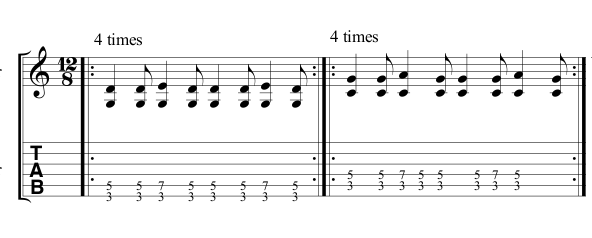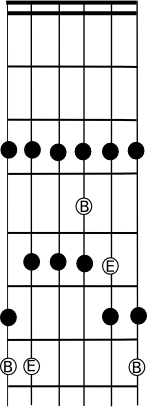Here is a practice track in a medium tempo blues feel. It is suitable for beginning and intermediate bass and guitar players to work with.  The chords are
||: G7             |                  |                    |                   |C7            |               |                |             : ||
A distinctive feature of many blues styles is the triplet feel – each beat is divided into three parts, counting 1 and a 2 and a 3 and a 4 and a etc.
Free MP3 download: G7&C7 blues feel at 80bpm
There are two rhythm guitar tracks accompanying the drums. One plays a typical shuffle rhythm accompaniment:
 The other plays G7 and C7 chords on the first beat of each bar and on every beat of the bar leading up to each chord change. This will help you to anticipate the chord changes, and adjust your playing accordingly!
The other plays G7 and C7 chords on the first beat of each bar and on every beat of the bar leading up to each chord change. This will help you to anticipate the chord changes, and adjust your playing accordingly!
For bass players:
(1) Start by playing a bass line using only tonics, G for the G7 chord, and C for the C7 chord
(2) Then try using tonics and fifths for each chord.
(3) Explore using the b7 for each chord. F for the G chord, and Bb for the C chord.
(4) Explore anticipating the chord changes with chromatic or diatonic runs up to or down to the new chord root (use the mixolydian modes built on the root of each chord for diatonic runs).
(5) Use G7 and C7 arpeggios to create bass lines.
For guitar players:
(1) Use the G minor pentatonic scale over both chords
(2) Use G major pentatonic scale over G7 and C major pentatonic over C7
(3) Use G and C mixolydian modes over G7 and C7 chords respectively
(4) Use a G minor pentatonic scale but add a B (major third) over the G7 chord, and an E (major 3rd of C) over the C7 chord. These notes can be obtained by fretting, or by bending from a note in the minor pentatonic scale. Here is a diagram in third position:
 The G minor pentatonic scale notes are in black, with the major thirds added in white.
The G minor pentatonic scale notes are in black, with the major thirds added in white.
Have fun!
